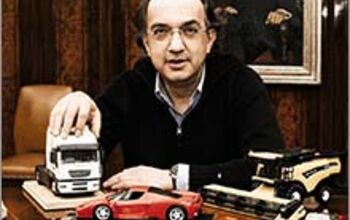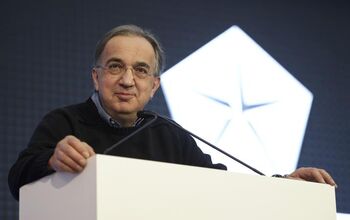Sergio Marchionne, Savior of Fiat and Chrysler, Dies At 66

With his passing, the auto industry returns to being a sea of suits. Sergio Marchionne, the outspoken, sweater-wearing former CEO of Fiat Chrysler Automobiles and newly spun-off Ferrari, has died following complications from a recent surgery. The Italian-Canadian industry titan was 66.
Marchionne had been expected to retire from FCA in the spring of 2019, but his rapidly failing health saw the boards of FCA and Ferrari assemble on Saturday to choose successors and issue notes of condolences. Jeep and Ram brand boss Mike Manley took the helm of FCA by day’s end. Late Tuesday, an Italian newspaper claimed Marchionne suffered an embolism following a high-risk cancer surgery, falling into a unrecoverable coma.
How does one remember such a colorful figure? With cars and quips.
When Marchionne announced the return of the Alfa Romeo brand to the United States at the 2013 Detroit auto show, he asserted that the future lineup needed a “wop engine.”
Thus began a steady stream of brutally honest pronouncements. When FCA grudgingly launched its first all-electric vehicle, the Fiat 500e, a grumpy Marchionne famously stated, “If you are considering buying a 500e, I hope you don’t buy it.” The automaker, forced into fielding a cobbled-together EV to satisfy California emissions laws, lost $14,000 on the sale of every 500e.
Sergio, as we all referred to him, was a refreshing, enlivening presence in a frequently dull, carefully scripted industry. But his achievements loom as large as his persona.
Joining the board of Fiat in 2003, Marchionne took the helm of the ailing Italian company the following year, nursing it back to profitability. He then turned his sights on a bankrupt Chrysler, left wallowing in the midst of a recession after Daimler AG lost interest and new owner Cerberus Capital Management failed to act like Chrysler was a car company. Fiat’s stake grew, from 20 percent in 2009 to 58.5 percent a few years later. In 2014, the company bought up the remaining shares, creating FCA.
Without Fiat — and Marchionne’s — interest, the U.S. and Canadian governments wouldn’t have been so quick to offer financial assistance during those dark times.
“I believe that the best way to honor his memory is to build on the legacy he left us, continuing to develop the human values of responsibility and openness of which he was the most ardent champion,” said John Elkann, chairman of investment firm (and largest FCA stakeholder) Exon, in a statement.
Under Marchionne’s guidance, Jeep grew from a quirky off-road-focused brand to a global juggernaut. Ferrari became an independent division with an IPO. Dodge lifted the horsepower of its Charger and Challenger into the stratosphere. Maserati returned to prominence, Alfa Romeo returned to North America, and small, domestic cars vanished from the automaker’s portfolio — an acknowledgement that crossovers are now king. Ram, once a line of Dodge trucks, is now positioned as a key global brand.
Shortly before his June surgery, Marchionne pulled the wraps off the automaker’s next five-year plan. In it, the two brands that make up the company’s name (as well as Dodge) were relegated to the back burner, while Jeep, Ram, Alfa Romeo and Maserati stand ready to take on the world (and make buckets of cash doing it). Yes, it means Chrysler, now a “people-mover” brand, falls further from the public eye, but Marchionne knew where the money was. Well, most of the time.
Failures on his watch were few, but notable. The Chrysler 200 sedan flopped, not unlike the entire Fiat brand in North America, while the launch of the Maserati Levante SUV and 2019 Ram 1500 haven’t been without difficulties (naturally, Marchionne addressed the latter two issues with unvarnished honesty). The 3.0-liter EcoDiesel saga gave FCA an environmental black eye. And, as other automakers scrambled to launch electric vehicles and plug-in hybrids, FCA managed to crank out the plug-in Pacifica and nothing else. Still, those hybrid vans sit at the center of Waymo’s self-driving ride-hailing plan, and FCA scored a lucrative order because of it.
Sergio liked sexy sheetmetal and muscle, but the man wasn’t blind to the potential benefits of emerging technologies. The five-year plan showed it. A full-fledged electrification strategy will see FCA finally get with the times, eliminating one of its largest risks.
During that plan unveiling in Turin, Marchionne spoke of the company in eloquent terms when asked about his successor, then unknown.
“There is no script or instructions. Instructions are institutional and temporary,” he said. “FCA is a culture of leaders and employees that were born out of adversity and who operate without sheet music.”
Having positioned his retirement to coincide with the elimination of FCA’s stubborn, longstanding debt, it’s now looking like Marchionne’s untimely departure from this physical realm comes as his streamlining plan achieved exactly that.
Rest easy, Sergio.
[Images: Fiat Chrysler Automobiles]

More by Steph Willems
Latest Car Reviews
Read moreLatest Product Reviews
Read moreRecent Comments
- ToolGuy If these guys opened a hotel outside Cincinnati I would go there to sleep, and to dream.
- ToolGuy Michelin's price increases mean that my relationship with them as a customer is not sustainable. 🙁
- Kwik_Shift_Pro4X I wonder if Fiat would pull off old world Italian charm full of well intentioned stereotypes.
- Chelsea I actually used to work for this guy
- SaulTigh Saw my first Cybertruck last weekend. Looked like a kit car...not an even panel to be seen.



































Comments
Join the conversation
Shocked and saddened to read of this. Condolences and prayers go to his family. He marched to a different beat and was always entertaining. I owe him a debt of gratitude for his decision to give Fiat (and Alfa) another shot in the US. I was able to purchase a new Fiat, which is something I never expected to happen again in my lifetime. I'm the proud owner of a 2012 500 Abarth, a car that after 6 years of trouble-free ownership, still brings a smile to my face every time I drive it. RIP, Sergio!
RIP Sergio. I enjoyed his cander and straight talking. My best to his family.